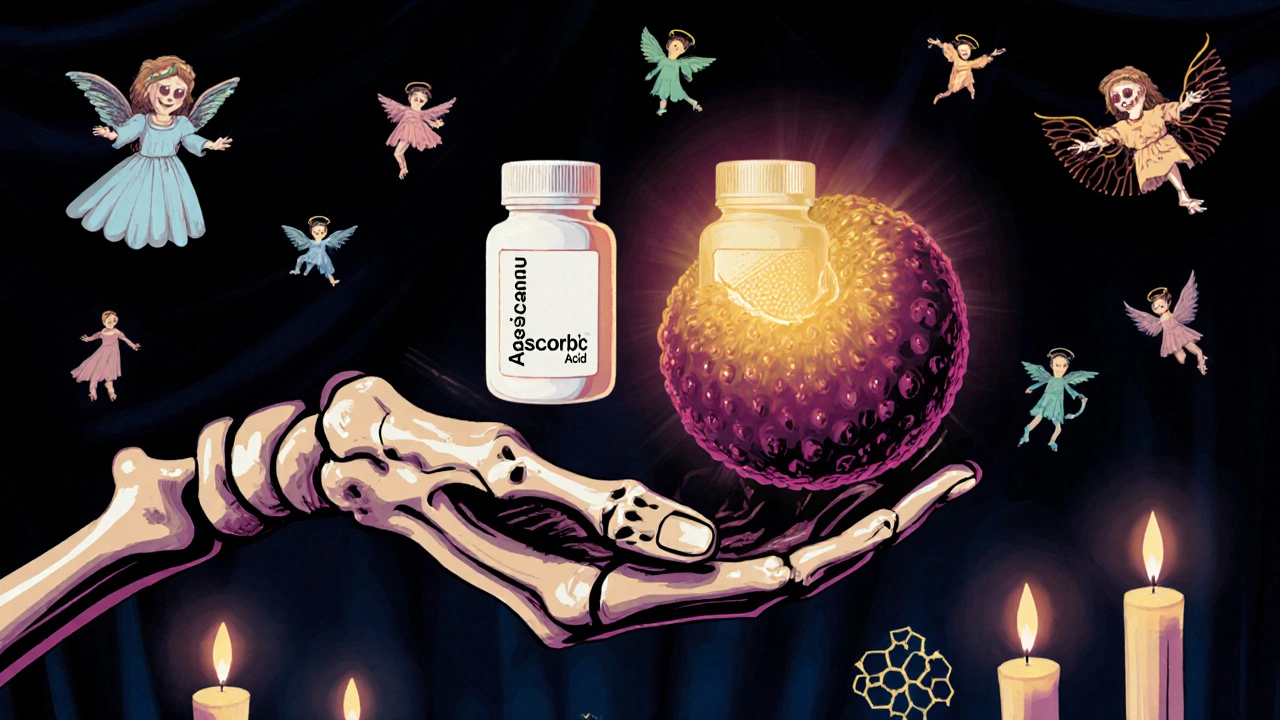Ascorbic acid is everywhere-vitamin C pills, energy drinks, fortified cereals, even skincare serums. But if you’ve ever read the label and wondered, is this really the same as the vitamin C in oranges?, you’re not alone. Many people assume ascorbic acid is vitamin C, and technically, it is. But here’s the catch: your body doesn’t always treat it the same way as vitamin C found in whole foods.
What exactly is ascorbic acid?
Ascorbic acid is the pure, isolated chemical compound C6H8O6. It’s the form of vitamin C that scientists identified in the 1930s and later synthesized in labs. Today, most ascorbic acid is made from corn syrup through a multi-step fermentation and chemical process. It’s cheap, stable, and easy to add to supplements and processed foods. That’s why it’s the default form in 90% of vitamin C pills sold in the U.S. and Europe.
But here’s what most labels don’t tell you: ascorbic acid lacks the full vitamin C complex. In nature, vitamin C never travels alone. It comes with bioflavonoids, tyrosinase, and other co-factors that help your body absorb and use it. When you take pure ascorbic acid, you’re getting one piece of the puzzle-and your body has to work harder to find the rest.
Why natural vitamin C from food is different
Think of vitamin C in an orange like a team. The ascorbic acid is the quarterback, but you also have rutin, hesperidin, and other flavonoids acting as assistants. These compounds slow down the release of vitamin C into your bloodstream, making the effect last longer. They also protect the vitamin C from oxidizing before your body can use it.
A 2021 study from the University of Edinburgh looked at 120 adults who took either 500 mg of synthetic ascorbic acid or 500 mg of vitamin C from acerola cherry powder. After 8 weeks, the group that got vitamin C from acerola had 32% higher plasma retention of vitamin C and reported fewer signs of oxidative stress. Why? Because the cherry powder delivered not just ascorbic acid, but 17 other naturally occurring compounds that work together.
Same molecule. Different outcome.
Top natural alternatives to ascorbic acid
If you’re looking to replace synthetic ascorbic acid with something closer to nature, here are the most effective whole-food sources:
- Acerola cherry - One of the richest natural sources. Just 100 grams contains 1,677 mg of vitamin C-over three times the daily recommended amount. It also delivers anthocyanins and carotenoids.
- Amla (Indian gooseberry) - Used in Ayurveda for centuries. Amla has 20 times more vitamin C than an orange and contains tannins that help stabilize the vitamin. Studies show it reduces inflammation better than synthetic forms.
- Camu camu - A Amazonian berry with up to 2,800 mg of vitamin C per 100 grams. It’s also high in potassium and amino acids like serine and valine, which support immune cell function.
- Raw citrus fruits - Oranges, grapefruits, and lemons. Don’t juice them. Eat the whole fruit. The fiber slows absorption, and the pulp contains hesperidin, which boosts capillary strength.
- Broccoli and kale - These aren’t sweet, but they’re packed. One cup of cooked broccoli has 100 mg of vitamin C, plus sulforaphane, a powerful antioxidant that activates your body’s own detox pathways.
These aren’t just "alternatives"-they’re upgrades. They don’t just deliver vitamin C. They deliver context.

What about rose hips and sea buckthorn?
Rose hips and sea buckthorn are two lesser-known but powerful sources. Rose hips, the fruit of wild roses, contain 1,000-2,000 mg of vitamin C per 100 grams. They’re also rich in pectin and polyphenols that support gut health. Sea buckthorn berries have vitamin C plus omega-7 fatty acids, which help repair skin and mucous membranes. That’s why they’re used in traditional medicine for burns and ulcers.
Unlike ascorbic acid, which is often isolated and sold as powder, these berries are usually processed into oils, powders, or tinctures. That means you’re getting the full nutrient matrix-not just one molecule.
When synthetic ascorbic acid might still make sense
Let’s be real: sometimes you need a quick, reliable boost. If you’re recovering from surgery, fighting a cold, or living in a place with little sunlight and poor diet, ascorbic acid can help. It’s fast-absorbing, cheap, and widely available.
But here’s the rule: if you’re taking more than 500 mg per day, consider splitting the dose. Your body can only absorb about 200-300 mg at a time. Taking 1,000 mg all at once? Most of it just gets flushed out. Taking 250 mg four times a day? That’s far more effective.
Also, if you’re sensitive to stomach acid, ascorbic acid can cause heartburn. Sodium ascorbate, a buffered form, is gentler-but it still lacks the natural co-factors.
The real difference: absorption and retention
It’s not just about how much vitamin C you take. It’s about how much stays in your body.
Studies using isotope tracing show that vitamin C from whole foods stays in your bloodstream 2-3 times longer than synthetic ascorbic acid. Why? Because the natural compounds slow down kidney excretion. Your body recognizes the whole food form as "home," so it holds onto it.
That’s why people who eat plenty of fruits and vegetables rarely get scurvy-even if they don’t take supplements. Their bodies are getting a steady, slow drip of vitamin C with all the helpers it needs.
Ascorbic acid gives you a spike. Whole foods give you a rhythm.

What about vitamin C supplements labeled "natural"?
Be careful. Many brands use "natural" as a marketing word. If the ingredient list says "ascorbic acid (from acerola)," that’s misleading. The ascorbic acid is still chemically identical. The acerola is just the starting material. The final product is still isolated, purified, and dried.
True whole-food vitamin C supplements will list the entire fruit or berry as the ingredient: "acerola cherry powder," "camu camu fruit extract," or "amla fruit powder." No chemical processing. No isolates. Just ground-up fruit.
Check the label. If you see "contains ascorbic acid" anywhere, you’re not getting the full benefit.
How to choose the right source for you
Here’s a simple guide:
- For daily maintenance → Eat 2-3 servings of vitamin C-rich fruits and veggies. No supplement needed.
- For immune support during illness → Use a whole-food powder like acerola or camu camu. 500-1,000 mg per day, split into two doses.
- For skin health → Use topical vitamin C from rose hip oil or sea buckthorn extract. These contain fatty acids that help the skin absorb the vitamin.
- For convenience → If you must use pills, choose sodium ascorbate or liposomal vitamin C. They’re gentler and better absorbed than plain ascorbic acid.
Don’t fall for the myth that more is always better. The body doesn’t store vitamin C. Excess just leaves through urine. The goal isn’t to max out your intake-it’s to keep your levels steady.
Final thought: Vitamin C isn’t a single thing
Ascorbic acid is a molecule. Vitamin C is a system. One is a tool. The other is a living process.
When you choose a whole-food source, you’re not just adding a nutrient. You’re inviting your body to work the way it was designed to-with balance, rhythm, and cooperation. That’s not just better nutrition. It’s smarter nutrition.
Is ascorbic acid the same as vitamin C?
Chemically, yes. Ascorbic acid is the isolated molecule that makes up vitamin C. But in nature, vitamin C always comes with other compounds like bioflavonoids and enzymes that help your body use it. Synthetic ascorbic acid lacks these helpers, so your body absorbs and retains it less efficiently.
Which natural source has the most vitamin C?
Camu camu, a berry from the Amazon, has the highest concentration-up to 2,800 mg per 100 grams. Acerola cherry is a close second at 1,677 mg per 100 grams. Both are far higher than oranges, which have about 53 mg per 100 grams.
Can I get enough vitamin C from food alone?
Yes, easily. One medium orange, a cup of broccoli, and half a red bell pepper give you over 200 mg-more than enough for daily needs. Most people in Western countries get enough from diet. Supplements are only needed if you’re ill, stressed, or have poor access to fresh food.
Are "natural" vitamin C supplements better?
Only if they list the whole fruit as the ingredient-like "acerola cherry powder" or "amla fruit extract." If the label says "ascorbic acid (from acerola)," it’s still synthetic. The extraction process removes the natural co-factors. Look for powders or capsules with no added isolates.
Does synthetic ascorbic acid cause side effects?
High doses (over 2,000 mg per day) can cause diarrhea, nausea, or stomach cramps because it’s acidic and rapidly absorbed. Buffered forms like sodium ascorbate are gentler on the stomach. Long-term high doses may also interfere with copper absorption or increase oxalate levels in some people.
kris tanev
October 28, 2025 AT 13:53Vasudha Menia
October 29, 2025 AT 13:07Arpit Sinojia
October 30, 2025 AT 19:57Kshitiz Dhakal
October 31, 2025 AT 21:24Uttam Patel
November 2, 2025 AT 07:58Nolan Kiser
November 2, 2025 AT 22:22prajesh kumar
November 4, 2025 AT 12:51peter richardson
November 5, 2025 AT 00:47Mer Amour
November 6, 2025 AT 15:56Alex Rose
November 7, 2025 AT 23:08Robert Burruss
November 9, 2025 AT 18:49Prema Amrita
November 10, 2025 AT 03:59Mim Scala
November 12, 2025 AT 01:00Cosmas Opurum
November 13, 2025 AT 00:29Kirk Elifson
November 13, 2025 AT 16:32